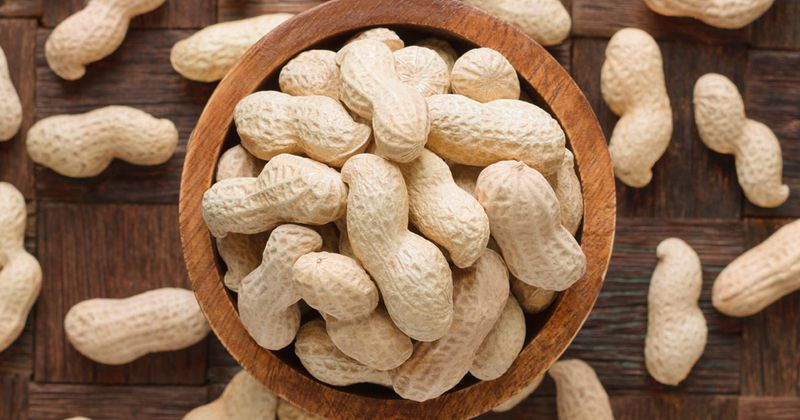Extended oral immunotherapy improves peanut allergy responses
Continued daily treatment with Peanut Allergen Powder-dnfp after its first year improves safety and tolerability profiles, as well as clinical and immunological responses, according to a study published in Allergy.
The researchers expected progressive desensitization with Peanut (Arachis hypgaea) Allergen Powder-dnfp (Palforzia, Aimmune Therapeutics), or PTAH, based on long-term treatment of 3 to 5 years with other forms of allergen immunotherapy, especially with subcutaneous therapy for patients with stinging insect allergies.

“As is well described in the literature, with stinging insect immunotherapy there is modulation of the immune response over time,” Mohamed Yassine, MD, senior vice president of medical affairs at Aimmune Therapeutics, a Nestle Health Science Company, told Healio.

“We felt an obligation to assess whether the same would be true with Palforzia treatment for peanut allergy and, in fact, so far with longer-term dosing up to 2 years, we have seen increased desensitization that was matched with continued tolerability and evidence of immunomodulation,” Yassine said.
PTAH, a first-in-class standardized oral biologic drug indicated for individuals aged 4 years to 17 years with a confirmed diagnosis of peanut allergy, mitigates allergic reactions following accidental exposure to peanuts. The oral immunotherapy’s active ingredient consists of defatted lightly roasted peanut flour, and it works via gradual desensitization with peanut protein.
“We worked with the FDA to establish precise acceptance criteria for Palforzia’s allergenic content and potency, ensuring that Palforzia is a well-characterized product that is controlled for potency with minimal variability between dose strengths and lots,” Yassine said.
Previous PTAH trials lasted for 12 months, and there are limited data beyond a year of treatment, said the researchers, who designed their study to test PTAH’s efficacy and tolerability at intervals of approximately 1.5 years and 2 years of treatment.
The current study involved 142 participants aged 4 years to 17 years when they were receiving daily doses of PTAH as part of the previous PALISADE and ARC004 studies.
“We know that peanut allergy typically begins in infancy and is usually permanent. Moreover, adolescents are at the greatest risk for experiencing severe allergic reactions with accidental exposures due to such factors as less parental oversight of their diets,” author Stacie M. Jones, MD, professor of pediatrics at University of Arkansas for Medical Sciences and Arkansas Children’s Hospital, told Healio.

“Taken together, there is a high unmet medical need in young children and adolescents,” Jones said.
The 110 participants in Group A of the study received 300 mg daily PTAH for approximately 1.5 years, and the 32 participants in Group B received it for approximately 2 years.
Main efficacy endpoints included desensitization to peanut protein — measured during a double-blind, placebo-controlled food challenge — the single highest administered dose, maximum severity of symptoms at each challenge dose and adrenaline use.
Results showed a greater proportion of those in Group B tolerated the highest food challenge dose of 2,000 mg peanut protein without dose-limiting symptoms after 2 years compared with those in group A at 1.5 years (80.8% vs. 48.1%).
Also, 24% of Group A and 3.8% of Group B received adrenaline as rescue medication, a majority of whom received it early in the desensitization process rather than during the maintenance period.
Most participants experienced treatment-emergent adverse events, but none were fatal or life-threatening. Most adverse events were gastrointestinal or respiratory in origin and mild to moderate in severity.
Researchers noted the total number of treatment-emergent adverse events decreased during the intervention period.
Additionally, the percentage of participants who demonstrated clinically meaningful improvements in their food allergy-related quality of life (FAQoL) generally rose as PTAH treatment continued.
Food Allergy Independent Measure results further indicated the greatest improvements in “likelihood of having a severe reaction” and “chance of dying from accidental exposure” among children aged 8 to 12 years and teenagers aged 13 to 17 years, with increases over the treatment’s duration.
“As expected, we saw continued improvements in efficacy, safety and longitudinal quality of life during the second year of Palforzia therapy. Now that Palforzia is commercially available, the surprising result has been that despite the FDA’s requirement for a Risk Management and Evaluation Strategy program, this step has been well perceived by both practitioners and patients,” Yassine said.
The researchers noted multiple limitations, such as the designs of and differences between the PALISADE and ARC004 studies. Perceptions of safety among the study’s researchers, providers, participants and caregivers also may have influenced the administration of adrenaline.
However, the researchers concluded that continued PTAH daily therapeutic maintenance dosing is safe and tolerable while reducing frequency of adverse events and improving ongoing immune response, peanut protein desensitization and FAQoL.
“We continue to follow patients treated with Palforzia in a long-term observational study. We also recently completed enrollment of a study examining Palforzia treatment in toddlers aged 1 to 3 [years], and we expect to have results of that study sometime in the second half of 2022,” Yassine said.
“Palforzia is appropriate therapy to incorporate into the practices of interested clinicians who are experienced with other forms of allergen immunotherapy,” Yassine said.
For more information:
Stacie M. Jones, MD, can be reached at jonesstaciem@uams.edu.
Mohamed Yassine, MD, can be reached at myassine@aimmune.com.
